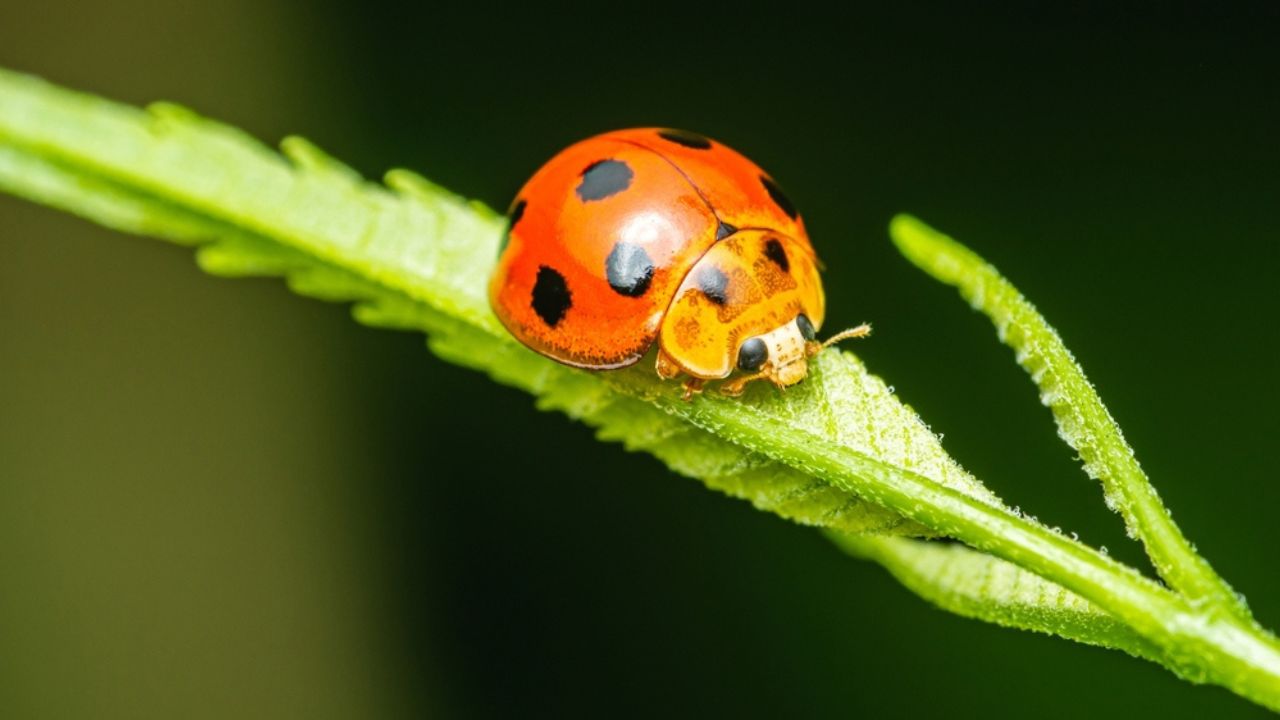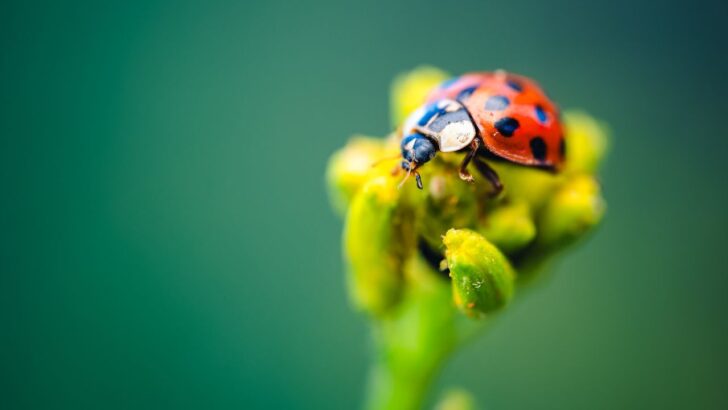Everyone knows how valuable bees are to your garden because they are pollinating your flowers. But they’re not the only beneficial garden insects – not by a long shot.
And to prove it, here’s a list of 10 of them (in no particular order) and how they can help in your garden. Beneficial garden insects are extremely helpful to have around because they serve important functions, such as consuming other pest insects and their eggs and larvae. Let’s examine some of these beneficial insects and explore why you want them around.
Beneficial Garden Insects For Every Garden
We spend a lot of our time as gardeners trying to protect our crops from pest populations, but there are some insects that you may want to keep around. Here’s what I’ve found from extensive research and my own experience in my thriving garden.
Keep in mind that bugs all exist in an important ecosystem that finds its own balance. While some bugs may seem totally unwanted, they likely still play an important role. Finding ways to keep them off your plants without using insecticides (like companion planting) is ideal when possible.
1. Bees

Image Credit: Shutterstock.
No list of beneficial garden insects would be complete without a mention of bees. They might have a harsh sting, but if you don’t provoke them and you allow them to do their thing, they will cross-pollinate your flowers to enable more flowers (and vegetables) to grow. These are some of the best insects to have in and around your garden, and they’re so good for the environment.
2. Ladybugs

Image Credit: Shutterstock.
Ladybugs (also known as lady beetles) feed on the insects that would damage your crops, including aphids, mealybugs, and other destructive pests. Plus, most people find them kind of cute.
If you see these in your garden, enjoy them! You can even buy ladybugs online to help with aphids (although there are natural ways to attract them too).
3. Spiders

Image Credit: Shutterstock.
OK, not technically an insect, but worth mentioning here: spiders’ benefits are twofold. First, they help control the population of unwanted insects, such as flies, mosquitoes, moths, and wasps, which helps prevent you from getting stung in your garden.
And the drop in the number of these insects also prevents your plants from being eaten by them. Spiders are definitely friends of the garden.
4. Midges

Image Credit: Shutterstock.
Like ladybugs, midges also feed on the aphids that damage crops. They also lay their eggs in the midst of aphid colonies, so when their babies are born, they attack the aphid colonies almost straight away.
5. Braconid Wasps

Image Credit: Shutterstock.
Female braconid wasps inject their eggs into host insects such as caterpillars and moths. The larvae then feed inside their insect hosts, effectively killing the host by the time the larvae are fully developed.
See the braconid wasps in action here, feeding on (and killing) tomato hornworms.
6. Damsel Bugs

Image Credit: Shutterstock.
You may have started to notice a theme to the beneficial bugs here. Here’s yet another. Damsel bugs feed on pesky pests such as aphids and small caterpillars.
7. Ground Beetles

Image Credit: Shutterstock.
Don’t worry that every beetle is bad for your garden. There are actually some beneficial ones, like the ground beetle. These are larger, more voracious predators. They will go after slugs and snails, cutworms, and cabbage maggots in your garden’s soil.
Soldier beetles are also a good thing for your garden. They are most beneficial in late summer when there are a lot of aphids around. The soldier beetle larva helps rid the garden of aphids as well as other predatory insect eggs, treating them at the source before they even hatch.
8. Green Lacewings

Image Credit: Shutterstock.
Both adult lacewings and their larvae will eat pesky aphids, caterpillars, and other garden pests. These natural predators are good for your garden because they get rid of pests that can harm your plants. Sometimes they will take nectar from flowers, but they won’t eat your plants or cause any harm to them, so they’re another good insect to have around.
9. Tachinid Flies

Image credit: Depositphotos.
The tachinid fly larvae, much like braconid wasp larvae, burrow their way into many caterpillars, destroying them from the inside. Although caterpillars will turn into moths and butterflies that bring beauty and pollinate your flowers, they are can also destroy your crops, so finding a balance is important with any bug management.
10. Minute Pirate Bugs

Image Credit: Shutterstock.
These quick-moving bugs will attack almost any insect! Don’t worry if you see these in your garden because they can do more good than chemical pesticides, and without the harmful side effects. That’s definitely an insect win!
How Insects Can Be Useful to Plants – Nature’s Own Pest Control

Image Credit: Shutterstock.
Did you know about all of these ways insects can be useful to plants?
Using nature’s insects to look after your garden plants is thought by many to be a superior method of pest control. After all, it’s minimizes the need for chemicals! You want your garden to feel like your own little patch of nature in your own backyard. A healthy garden will have insects, just not the kinds that kill your plants.
Spraying man-made chemicals or pouring strange chemical pellets around is not necessarily the only way to achieve it. You can always go back to nature, using insects alone, and cultivate your garden 100% organically, just as nature intended.
Insect pests include potato beetles, as well as in their larval stage, Japanese beetles, aphids, leaf beetles, vine weevils, caterpillars, cutworms, cabbage maggots, and the tarnished plant bug, just to name a few. But for each of the Japanese beetles you see, there is a beneficial beetle you want in your garden. It’s all about learning the difference and creating a garden environment that works for your needs and attracts good insects while repelling the bad ones.
Beneficial Garden Insects Identification

Image Credit: Madu Oliveira at Shutterstock.
When your garden is littered with insects, it’s important to distinguish between those that are beneficial and those that are pests that will damage your crops.
These days, identifying an insect in your garden (in order to ascertain whether it’s beneficial) has never been easier – there are apps dedicated to it!
If you have an Android smartphone or device, or an Apple one, simply download the free app, Picture Insect – Insect ID Pro. All you need to do is snap a photo of the insect you want to identify, and the app will match it up in less than a second. Then you’re presented with a little fact file – so handy for determining whether an insect is beneficial to your garden!
If you’re using a Windows phone or device, you don’t have to feel left out. There’s a Windows app that does the same thing. There are just 2 drawbacks: it isn’t free, (but then again it only costs about $5), and it’s only for the PC, so you’ll have to upload the insect photo from your smartphone or device to your PC. The app is called Insect Identification.
These are by no means the only apps on the market but we’ve specifically mentioned them here because they had the best feedback in the app stores.
Plants that Attract Beneficial Insects

Image Credit: Shutterstock.
You don’t need to buy these beneficial insects and import them into your garden. You can simply attract them into your garden by creating a great environment to attract them.
Although many of the insects that feed on your garden’s pests get much of their nutrition from the prey, they also need energy from carbohydrates in your plant’s nectar. That makes your plants and flowers pretty essential for attracting your beneficial garden insects.
Ladybugs particularly like:
- alyssum
- buckwheat
- coriander (learn how to grow coriander)
- fennel
- dill (learn how to gro dill)
- sunflowers
- common yarrow
- Rocky Mountain penstemon
- Queen Anne’s Lace
Lacewings enjoy many of the same flowers as the ladybugs, but they also like:
- angelica
- caraway
- cosmos
Plants that attract beneficial insects include some annual plants and many perennial plants. And they’re not limited to flowers: trees and shrubs can attract beneficial insects too.
Quite often using an annual plant to attract beneficial insects will do the trick, but if you wanted to hedge your bets, you could invest in a perennial plant.
Here are our top 5 flowers for attracting beneficial insects
Yarrow

Image Credit: Shutterstock.
Tarrow is a perennial flower that comes in a range of colors including red, yellow, and white. It attracts a wide variety of predatory insects, but also some butterflies.
Marigold

Image Credit: Shutterstock.
An annual orange and yellow flower helps with both above-ground pests and pests that attack vegetables from below. Marigolds can be easily mixed in vegetable beds.
Sweet Alyssum

Image credit: Depositphotos.
Sweet alyssum is a white flower with a gorgeous honey scent. It’s a ground-hugging annual that will remain in bloom for months on end. And once planted them once, it will sprout again year on year on year.
Coneflower (AKA echinacea)

Image Credit: Shutterstock.
This is a tall perennial flower with two-foot-tall stalks, in a beautiful shade of purple. They are perhaps best positioned to form a border for your vegetable garden.
Goldenrod

Image Credit: Shutterstock.
Although the blooming of goldenrods can start in the spring, it can continue into fall. This is crucial to prevent your beneficial garden insects from leaving. And its loose yellow blossoms look quite striking too.



8 Best Companion Plants For Squash (And 4 To Avoid)
Sunday 23rd of April 2023
[…] also provide benefits such as attracting pollinators to improve fruit formation, attracting other beneficial insects, reducing pest pressure, and encouraging healthy […]
7 Great Companion Plants For Lavender (And 3 To Keep Away From Them)
Sunday 16th of April 2023
[…] plants have showy blooms on stiff stems that are perfect for cutting and displaying. Zinnias bring beneficial bugs like ladybugs, butterflies, parasitic wasps, and bees to the […]
11 Best Companion Plants For Strawberries (And 6 To Avoid)
Wednesday 28th of December 2022
[…] scent of strawberries and keep them safe from pests. And when it is allowed to flower, sage can attract some beneficial insects as […]
13 Best Companion Plants For Basil (And 5 To Avoid)
Monday 28th of November 2022
[…] Marigolds and basil make a super companion pair in the vegetable garden, as both repel many pests, and marigolds have the added benefit of attracting beneficial insects. […]
11 Best Companion Plants For Hydrangeas
Monday 20th of June 2022
[…] and rabbits, but are a magnet for bees, butterflies, and hummingbirds, bringing large numbers of beneficial insects and pollinators to the […]